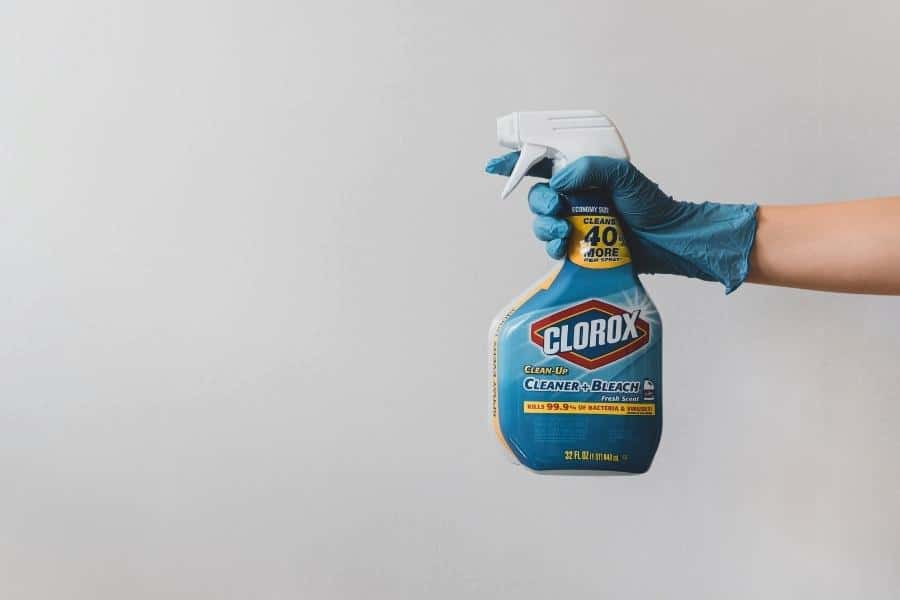If you buy something through a link in our posts, we may get a small share of the sale.
Carboys are used to ferment beer and store the lager, ale, or wine until it’s ready to drink. That’s why they must be sanitized before each use to prevent contamination. Therefore, knowing how to sanitize a carboy is essential for any homebrewer or winemaker and is not difficult to do.
Contents
How to Sanitize a Carboy
The most effective way to sanitize a carboy is to add 1 teaspoon of bleach per gallon of water and then fill the carboy with the mixture. Next, swirl the solution inside the carboy for several minutes to ensure all surfaces are in contact with the sanitizing solution. After swirling, let the carboy soak for at least 30 minutes. Finally, pour out the sanitizing solution, rinse the carboy several times with clean water, and let it air dry.

You can also use a no-rinse sanitizer such as Star San. Simply add the recommended amount of sanitizer to the carboy and fill it with water. Then, swirl the solution inside the carboy for several minutes to ensure all surfaces are in contact with the sanitizing solution. This will sanitize the carboy without the need to rinse it out afterward.
Sanitizing a carboy is essential in brewing or winemaking to prevent contamination. It also helps prolong the life of your fermenting vessel and the quality of your homebrew or wine. Unfortunately, many homebrewers forget to sanitize their carboy after each use, which can lead to off-flavors and spoilage. So, always remember to sanitize your carboy before each use!
Simple Steps to Sanitize a Carboy
Sometimes it can be difficult to keep your brewing equipment clean. However, cleaning and sanitizing your carboy before each use is important as you will come up with a more flavorful beer. Here are some simple steps you can follow to sanitize your carboy:
Step 1: Assemble Your Materials
Of course, you must have the cleaning materials on hand before starting. You don’t want to be in the middle of cleaning and realize you’re out of supplies. Here is a list of what you will need:
- Cleaning brush (specifically for carboys)
- Sanitizing solution (made specifically for brewing or a very weak bleach solution)
- Water for rinsing
- Towel or rag to help you dry the carboy
Step 2: Remove the Carboy Cap and Neck Guard
Before doing anything else, you must take off the carboy’s cap and neck guard. If you don’t, it will be difficult to reach the inside of the carboy with your brush. Also, ensure the carboy is completely empty. This way, the cleaning process will be much easier and faster.
Most of the time, the neck guard is easy to remove. If it’s stuck, don’t force it as you might break the carboy. Instead, soak it in hot water for a few minutes until it loosens up. As for the carboy’s cap, twist it counterclockwise until it comes off.
If you can’t remove the cap, don’t worry. You can clean the carboy without taking it off. Just be extra careful not to splash any water or cleaning solution inside the carboy.
Step 3: Fill the Carboy With Water
Using room-temperature water, fill the carboy until it’s about three-quarters full. Then, put the neck guard and cap back on. Next, swirl the carboy vigorously for a minute or two. Many of the hard-to-reach spots will have water in them after this step.
After shaking or swirling, let the carboy sit for a few minutes. Most sanitizing solutions have instructions on how long the carboy should sit. As a general rule, it’s usually about 10-30 minutes. However, the longer the carboy sits, the more effective the sanitizing solution will be able to work.

Step 4: Drain and Brush the Carboy
Once the carboy has sat for the appropriate amount of time, open it up and let all the water drain out. If you’re using a sanitizing solution, make sure to follow the instructions on how to dispose of it properly. You don’t want to contaminate your work area accidentally.
Now, it’s time to break out the cleaning brush. Start at the top of the carboy and work your way down. Be sure to brush the inside of the neck as well. It can be easy to miss this area, and it’s important to clean it thoroughly.
Step 5: Rinse the Carboy With Water
Using fresh water, rinse the carboy a few times. Make sure to get rid of all the soap suds and cleaning solutions. It’s also important to rinse the neck of the carboy. If there is any soap or sanitizing solution left in the carboy, it could affect the taste of your beer.
Hot water works best for this step; however, you can also use cold water. If you use hot water, be careful not to splash any on yourself. You don’t want to scald yourself accidentally.
Step 6: Dry the Carboy
Once you’ve rinsed the carboy thoroughly, you need to ensure that it’s completely dry before using it. Water left in the carboy could lead to bacteria growth. To dry the carboy, use a towel or a rag. You can also let it air dry for a few minutes.
Once the carboy is dry, put the neck guard and cap back on. Your carboy is now ready to be used. You can store it until you’re ready to use it or immediately fill it with your homebrew.
At times, you might need to clean your carboy more than once. If you notice any dirt or grime build-up, don’t hesitate to give it a good cleaning.
Importance of Cleaning and Sanitizing
Cleaning and sanitizing your brewing equipment is crucial to making great beer. Therefore, you must start with clean and sanitized equipment every time you brew. The following are a few reasons why it’s so important:
- Cleaning removes dirt, grime, and other build-ups from your brewing equipment. This build-up can affect the taste of your beer.
- Sanitizing kills bacteria and other organisms that could contaminate your beer. This is especially important if you’re brewing beer with fruit or other ingredients that could harbor bacteria.
- Cleaning and sanitizing your equipment is the best way to prevent infection. Infections can ruin an entire batch of beer and are difficult to get rid of once they start.
- It helps prolong the life of your brewing equipment. Regular cleaning and sanitizing will help prevent rust and other corrosion, extending your equipment’s life.
- It ensures that you have a consistent product. If your equipment is not properly cleaned and sanitized, the quality of your beer will suffer.

Frequently Asked Questions
Do You Need to Sanitize a Carboy?
Yes, you need to sanitize your carboy before using it. This is because the carboy can harbor bacteria that could contaminate your beer. It can also affect the taste of your beer if it’s not cleaned correctly.
How Do You Clean and Sanitize a 5 Gallon Carboy?
To clean and sanitize a 5-gallon carboy, fill the carboy with 4 ounces of bleach and 5 gallons of water. Let it sit for 30 minutes, then drain and rinse the carboy thoroughly. Be sure to brush the inside of the carboy with a cleaning brush and rinse it well. Let the carboy air dry or dry it with a towel before using it.
Can I Use Vinegar to Clean My Carboy?
Yes, you can use vinegar to clean your carboy. However, you’ll need to rinse it thoroughly with water afterward. This is because vinegar can affect the taste of your beer if it’s not rinsed off thoroughly. It can also leave a residue that could harbor bacteria.
Conclusion
Cleaning and sanitizing your carboy is an essential step in brewing great beer. Doing so will remove any bacteria that could contaminate your beer. You will also prevent the carboy from affecting the taste of your beer. When cleaning and sanitizing your carboy, use hot water and rinse it thoroughly.

